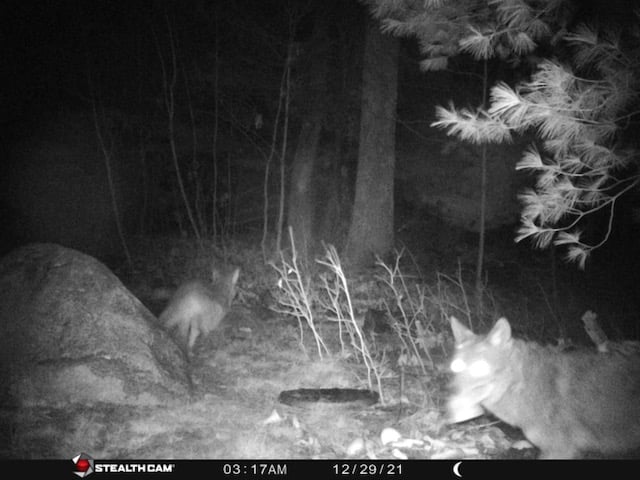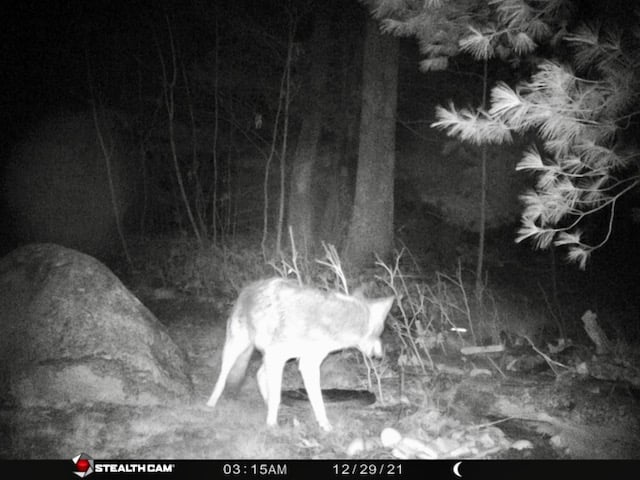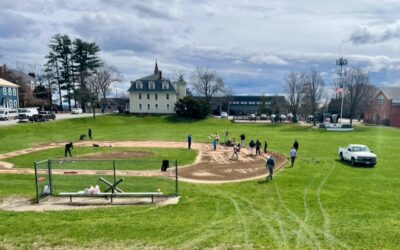Above: A coyote in the Burnett-Testa’s backyard.
Before I tell you about my coyote mistake, I need to tell you a rat story.
A friend of mine from Connecticut said that he was surprised to see a rat in his barn. He never saw a rat in 18 years of living on his farm so he set a trap and caught it. Then he saw another rat and did the same thing. After three weeks, he had caught 56 rats!
The rat invasion was alarming. He caught all 56 rats using spring-loaded traps, a little dangerous because sometimes the trap would go off and almost snap off one of his fingers. I told him he should have used poison, but he reminded me that if he did, the rats would die outside and that would cause the poison to reside in the food chain when other animals scavenged the body of the rat. Point taken.
After that 56th rat was trapped, they stopped coming. I like to think the rats read about how dangerous his farm was from the Police Log in their own hyperlocal, online news website. But the real story behind the sudden appearance and disappearance of the rats involved another resident of his town. A woman there had started to feed the rats outside of her house some months before rats began showing up at the farm. The rats reproduced quickly (as they do) and had lots more rats. Each generation pushed the other out away from the house until they reached his farm a mile down the road. When environmental officials stopped her from feeding the rats, the rat population declined.
Now back to coyotes. We are going to have to be able to live with them in East Greenwich. They are not going away. Even if our town eliminated a local pack of coyotes, beta coyotes or transients would move in. And any surviving female coyotes would breed at an earlier age and have bigger litters in response to any aggressive removal of a pack.
 My coyote mistake was forgetting that coyotes are one of the most adaptable and opportunistic animals in our area. I was putting old fruit in my compost pile and it was not secured. My trail camera caught a couple of coyotes near my pile and although this did not lead to any negative incidents, it was unsettling to think I was causing coyotes to put my backyard on their weekly food circuit.
My coyote mistake was forgetting that coyotes are one of the most adaptable and opportunistic animals in our area. I was putting old fruit in my compost pile and it was not secured. My trail camera caught a couple of coyotes near my pile and although this did not lead to any negative incidents, it was unsettling to think I was causing coyotes to put my backyard on their weekly food circuit.
So in East Greenwich we should keep our garbage cans tightly closed, keep our pet food and pets inside at night, and keep compost secure by using a compost bin. If we don’t do that, we will inadvertently become that woman who fed the rats and, in turn, increase our own coyote population.
I subsequently secured my compost pile to make it inaccessible to coyotes and called a local coyote expert, Numi Mitchell from The Conservation Agency, with some questions about coyote behavior. Here’s our conversation:
What is the average number of coyotes in a pack? It sounds like 15 to 20 when they howl around the High Hawk neighborhood.
Usually 4, sometimes 5. It depends on the resources available. A less dominant coyote may be allowed to stay if there are enough resources.
If coyotes are not eating garbage or people’s food, what is their diet in the winter?
Coyotes will scavenge roadkill, especially deer or even take down a weakened deer themselves. They may take a week to eat the whole animal. In the summer coyotes will eat woodchucks, rabbit, raccoon and roadkill, but their favorite meal to eat are meadow voles.
Tell me about mating season for coyotes in Rhode Island.
Coyotes can stay together for multiple years and begin mating during November, December and January. If there is competition for food, younger coyotes of a pack will be “pushed” out of the pack.
Do coyotes aggressively defend their young, like black bears?
Coyotes do protect their pups. Usually the males will stare at people like how a parent might stare at different people when their child is at a playground.
Where do coyotes sleep at night?
Coyotes curl up in an open field in good weather. They find evergreen plants when there is snow and they only use dens for pups when the mother is nursing. After pups are born in April, they move the dens when the fleas get bad. It’s like a shell game in how they keep their pups hidden.
How big is the territory of a coyote?
It depends on the food subsidies. It can range from 3 to 7 square miles.
Numi also told me she knew of a coyote pack that would ignore all the animals on a farm and only hunt the meadow voles in the field. The parents in this pack taught their pups to ignore the other animals and only to hunt the voles. It was a situation the farmer appreciated. In response, the farmer never shot a gun to scare away the coyotes because he knew these coyotes would not harm his animals.
I know it can be startling to see a coyote. My daughter saw one pop out of the woods while walking our dog but that coyote turned around and ran back into the woods. That’s normal behavior.
If you see a coyote hanging out in your yard, HERE is a helpful short video on what to do, provided by The Conservation Agency.
One last thing: Coyotes do not howl to celebrate a kill. They howl to bring their pack together and to tell other coyotes to not enter their territory. A coyote howl is one of the most primal, haunting sounds in nature and it is one of my favorite natural events.
You can learn more about coyotes in Rhode Island at the The Conservation Agency website HERE.
Anthony Burnett-Testa teaches computer science at Cole Middle School and works at East Greenwich News.






 Subscribe
Subscribe
interesting facts. Hope it provides thoughtful consideration to some whose first reaction is that wild animals have to be eliminated from neighborhoods.
Thank you for the informative and well-written article that relies on science and facts. Too often people rely on nonsense and information passed along to get the most reaction out of everyone. This results in hysteria about the “savage” nature of every animal that is not a cuddly pet. Hence the bad reputation of fishers. Well done!
Interesting. I live off middle road near carr’s pond and since we moved here 6 years ago we always hear coyotes. The packs sound way bigger than 5-6 but what would I know. I am usually in fetal under the covers…
In the winter coyotes are eating the deer roadkill that DEM dumps in numerous areas in and around EG. DEM should be more responsible and bury these deer carcasses instead on leaving them in piles for the wildlife to eat.
Jay, I called DEM and they said they place the road kill in a pit on state land. But the pit is in a locked area so coyotes can’t access the free resource. When the pit gets too full they burn the carcasses. I’ll look into this more when I write about a Road Kill Project that I used to do with students when I taught science.
I am grateful to DEM because they removed a deer carcass from my backyard. A coyote meal he couldn’t quite finish.
Pieces went back into my woods, but rest of the carcass went away in the truck.
This is very interesting. Thank you.
One other interesting fact: When a female coyote is pregnant, and if and when the food sources to provide for their rearing are low, the female can RESORB(some or ALL) of the fetuses as not to give birth to pups that she cannot afford to raise.
How dang COOL is THAT??!?!
Anthony, thank you for publishing such a well written and thoughtful article. I’ve spent a lot of time tracking the population in my town, and it really has been fascinating.
Coyotes are definitely misunderstood. An article like yours goes a long way in offering insight into their ecology and why they behave the way they do. Once you have that, it’s much easier to take steps like you did with your compost pile.
Great article, Anthony!
My yard is a travel route for coyotes their den is very close by we catch them on our security cameras.